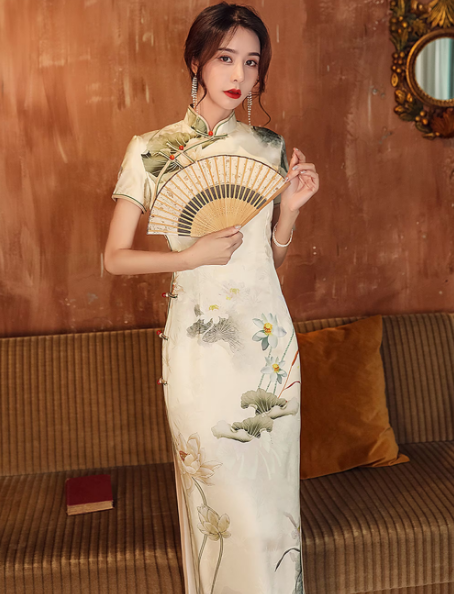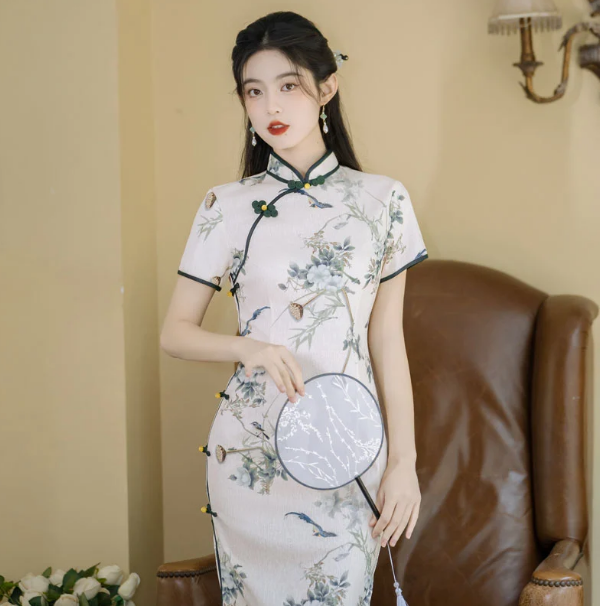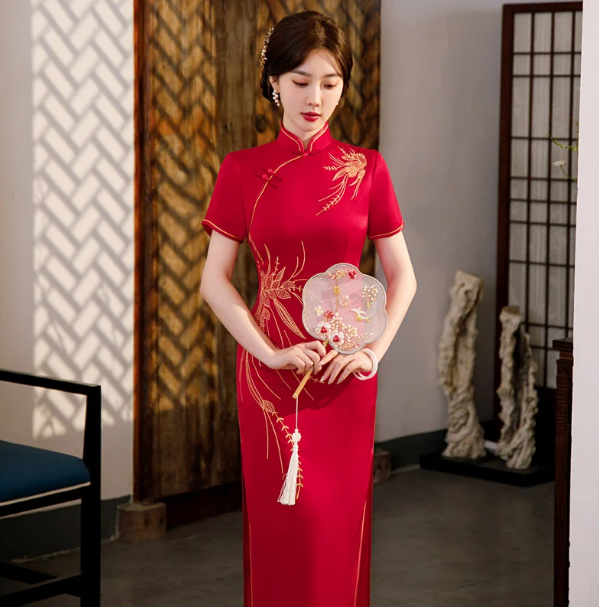Historical Significance
Origins of the Cheongsam
The cheongsam, known as qipao in Mandarin, traces its roots to the Qing Dynasty (1636-1912), where it began as a simple, loose dress meant to cover the body modestly. Manchu women wore these one-piece garments, which later became the standard female attire after the Manchu established the Qing Dynasty. The original qipao was wide and baggy, but as time went on, the dress became more form-fitting and elaborate, symbolizing both social status and ethnicity.

Evolution Through the Dynasties
Over the centuries, the cheongsam saw numerous transformations reflecting social changes. During the early 20th century, Shanghai emerged as a fashion hub, where the qipao evolved into a more fashionable and body-hugging dress, often made from silk and featuring high slits. This era saw the cheongsam take on a new role, expressing both modernity and femininity. Women from all walks of life, from students to celebrities, embraced the garment, enhancing its popularity across the social spectrum.
To see detailed accounts of the cheongsam’s history, you can refer to its Wikipedia page.
While maintaining the original aesthetic, modern-day designers often experiment with fabrics and cuts, bringing this historical garment into the 21st century without losing its iconic status. Each adaptation represents an era’s values and trends, making the cheongsam a timeline of fashion in itself.
Cultural Symbolism
Cheongsam in Chinese Traditions
Cheongsams often make an appearance during significant events like Chinese New Year, weddings, and tea ceremonies, serving as a connection to heritage. The garment embodies the Chinese aesthetic principle of “sanzijing” (三整齐), which means “three tidy appearances”—neat hair, neat clothes, and a neat appearance. It’s a popular choice among women for its elegance and the way it gracefully presents the wearer’s figure.
During weddings, red cheongsams, imbued with symbols of luck and happiness, showcase the cultural importance of color and design. Dragons and phoenixes, often embroidered on the fabric, signify a harmonious balance between male and female energy.
Representation in Modern Media
Modern media often use the cheongsam to represent Chinese culture, with the dress appearing in films, TV shows, and fashion magazines. For instance, in the international hit movie “In the Mood for Love,” the lead actress wears multiple cheongsams that reflect the fashion of the 1960s in Hong Kong. Each appearance of a cheongsam in media not only highlights its beauty but also reinforces its status as a cultural emblem.
For more detailed exploration of the cheongsam’s impact on culture and its representation in media, Wikipedia offers extensive information.
The cheongsam, through its fabric and design, tells a story of cultural identity, connecting wearers and viewers to a rich historical tapestry. In an age of globalization, the cheongsam stands out, symbolizing a nation’s journey through time while also embracing modern influences.
Aesthetic Appeal
Design and Elegance of Cheongsam
The cheongsam captivates with its timeless elegance, defined by a high collar, snug fit, and slits at the sides. Its beauty lies in its simplicity and its ability to accentuate the natural grace of the human form. The traditional silk material used not only provides a lustrous sheen but also offers a smooth texture that complements the wearer’s movements.
Designers often incorporate intricate patterns, such as florals or landscapes, which hold various meanings in Chinese culture. A peony might symbolize wealth and honor, while bamboo could represent resilience. Each pattern chosen enhances the aesthetic value of the dress while embedding cultural stories within the fabric.
Variations and Modern Interpretations
Contemporary interpretations of the cheongsam maintain its classic lines while infusing modern elements. Fashion designers experiment with materials like cotton, linen, and even leather, pushing the boundaries of the cheongsam’s traditional image. Lengths vary from the daring mini to the elegant maxi, catering to diverse fashion senses.
In recent fashion shows, designers have showcased cheongsams paired with accessories like belts, scarves, and even sneakers, demonstrating its versatility. These modern takes on the cheongsam pay homage to the original while allowing wearers to express individual style and contemporary trends.
For more insight into the fabric and design qualities of the cheongsam, Wikipedia provides detailed descriptions and examples.
The cheongsam remains a beloved garment globally, not only for its inherent beauty but also for its adaptability to modern fashion sensibilities. It’s a garment that transcends time, continuously evolving without losing the essence of its traditional allure.
Social and Political Context
Cheongsam During Political Movements
The cheongsam, once a symbol of the nationalist movement in China, became a sartorial statement of cultural identity and pride. During the May Fourth Movement in 1919, intellectuals called for modernization and women’s liberation, which also reflected in the changing fashions of the time. Women traded in their traditional bindings for the cheongsam, which symbolized both modernity and nationalism.
As political tides shifted, so did attitudes toward the cheongsam. During the Cultural Revolution, the garment became associated with bourgeois decadence. Many saw it as contrary to the ideals of simplicity and uniformity promoted by the government.

The Cheongsam in International Relations
On the global stage, the cheongsam plays a role as a cultural ambassador for China. At international events like state dinners and diplomatic meetings, female Chinese dignitaries often wear cheongsams. This choice showcases China’s rich cultural heritage and soft power.
The cheongsam has also seen diplomatic use in ‘panda diplomacy’, where the gift of pandas to other countries often coincides with the presentation of cheongsams, symbolizing friendship and the exchange of culture. The garment’s elegance and distinctiveness make it an ideal cultural representative, speaking volumes about China’s history and its place in the world today.
For a more comprehensive understanding of the cheongsam’s place in social and political movements, one can delve into the historical context on Wikipedia.
The cheongsam thus weaves through the fabric of China’s social and political narrative, marking periods of change and continuity, and acting as a vessel for cultural diplomacy on the international stage.
Personal and Psychological Aspects
Cheongsam as a Personal Identity
Wearing a cheongsam can be a profound personal statement, often reflecting an individual’s pride in their heritage. For many, it serves as a connection to ancestry, a wearable link to the past. In multicultural societies, a cheongsam can assert cultural identity and diversity, standing out in a sea of western attire.
In modern China, the resurgence of the cheongsam speaks to a renewed interest in traditional culture among the youth. It’s not uncommon to see the younger generation donning cheongsams at special occasions, signaling a blend of respect for their heritage with contemporary fashion.
Psychological Impact of Wearing Traditional Attire
The act of wearing a cheongsam can significantly affect self-perception and confidence. It’s not just clothing; it’s an embodiment of elegance and cultural confidence. Research suggests that traditional attire can bolster pride in one’s cultural background and foster a sense of belonging.
Moreover, the cheongsam often symbolizes femininity and empowerment. The choice to wear this garment can be both a personal and political statement, offering a sense of empowerment in societies where western attire dominates. For those in the diaspora, it can be a reminder of roots and a statement of individuality.
To understand the broader implications of traditional attire on personal identity, the psychological dimensions can be further explored through resources such as Wikipedia.
In summary, the cheongsam carries weight beyond its silk threads, deeply intertwined with personal identity and psychological well-being, highlighting the complex interplay between what we wear and how we perceive ourselves.

Preservation and Revival
Efforts to Keep Cheongsam Relevant
Cultural enthusiasts and fashion designers alike are pioneering efforts to keep the cheongsam relevant in modern society. Workshops and exhibitions highlight the artistry involved in making a cheongsam, often emphasizing the meticulous craftsmanship required for its traditional silk fabrics.
Initiatives like ‘Cheongsam Day’, where individuals are encouraged to wear the garment, have gained traction in various communities, promoting its visibility and continual wear. Additionally, educational programs aim to inspire younger generations to appreciate this cultural emblem by integrating its history into curriculums.
Cheongsam in Contemporary Fashion Shows and Events
Fashion designers regularly showcase cheongsams on the runway, presenting them as high fashion rather than mere traditional dress. These shows often highlight the versatility of the cheongsam, showing its potential when made from unconventional materials or paired with contemporary styling.
Global events like the Shanghai Fashion Week have seen the cheongsam take center stage, with models strutting in modern interpretations that honor the original design while pushing the envelope. The media coverage of such events helps to maintain the cheongsam’s presence in the fashion conversation.
Exploring the cheongsam’s journey through fashion’s evolution can provide deeper insights into its preservation efforts. Interested readers can find more detailed accounts on platforms such as Wikipedia.
The commitment to keeping the cheongsam relevant is evident in the continuous efforts to bridge the gap between its storied past and its potential future, ensuring that this iconic garment remains a fixture in both the fashion industry and cultural discourse.







